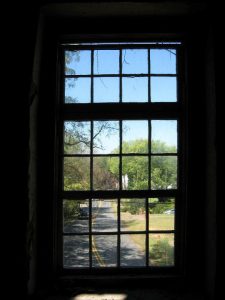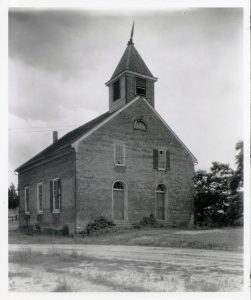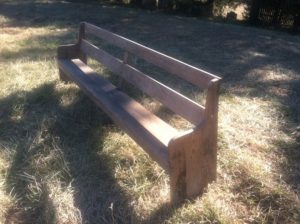When the storm destroyed Union Church’s roof in 1950, there wasn’t much to be done about it. It had not been used since 1935, after all, and rebuilding a church requires a committed congregation. But churches are centers of the community, and, during its lengthy, active history, Union Church was established as an important part of Falmouth’s past - and America’s, too. So, in an effort to preserve what they could, local people bricked up the narthex (the front of the church) to house a few things from years gone by, including a bell and a pew dating to just after the Civil War. What we see today is a slice of the original building, but that building has quite a history and what was preserved will soon be shared at the new National Museum of African American History on the
Washington Mall.
Located on the site of older Anglican churches, the Union Church was named thus because it did not belong to any particular denomination. During its time of use (c. 1824-1935), it could be used by any Christian denomination. Until 1892, it was the only church in Falmouth, with several services held by different groups each week.
Union Church and African American History
The outside of the church tells an important part of the story. There are two entrances, side by side. One led to the main part of the church--that one was for whites. The other led to the balcony where free and enslaved African Americans would sit. During the period leading up to the Civil War, African Americans were required by law to have sermons given by a white minister.
Even so, Anthony Burns, born in Stafford County as an enslaved person, preached there in the 1850s. He ran away in 1854 to the free state of Massachusetts but, under the authority of the Fugitive Slave Act of 1850, he was captured, put on trial and sent back to his owner. His trial caused a huge sensation, and abolitionists successfully raised money to buy him back to grant him his freedom. As was and is common, Burns asked the Union Church to send “a letter of dismission” and recommendation to a similar church near Oberlin College, where he was studying. Instead of granting that, his high-profile case made such a request a subject of scrutiny, and, not only was Anthony Burns denied his request, he was also excommunicated by the Baptist congregation. Anthony Burns eventually moved to Canada where he continued to preach, but he died at a young age from tuberculosis.
Another minister who preached at Union Church was eventually run out of town for his abolitionist ideas. Moncure Daniel Conway, the son of a local plantation owner, became unwelcome in his community in the years leading up to the Civil War. Both his mother’s teachings and his studies at Harvard’s divinity school had led him to believe that all people should be free. Indeed, he was believed to have been involved with efforts to free Anthony Burns. During the Civil War, he accompanied 31 of his father’s enslaved people from Washington, D.C. to Yellow Springs, Ohio, to freedom and helped establish what became known as “the Conway Colony.”
The Civil War and Reconstruction
The Union Army used Union Church as both a hospital and barracks. In April of 1862, a skirmish led to one Union officer and six soldiers being killed. Newly occupied, Falmouth’s only church was used as a hospital, and then its graveyard was used to inter the Union soldiers, some of whom were re-interred at the National Cemetery in Fredericksburg.
Later, when the church was used as a barracks, the pews were torn out and used for firewood. But circa 1868, with men well and truly home from the war, the church was put back together again. A simple pew from that time, preserved in the narthex, was donated to the Smithsonian’s National Museum of African American History and Culture as part of its “Slavery and Freedom” exhibition. Soon it will be on display for thousands of Americans to see each year, a symbolic link between two men who were both caught up in the fight for enslaved people's freedom and what came after.
In 2006, Union Church was put on Preservation Virginia's list of most endangered historic sites. In 2008, it was declared a Virginia State Landmark and put on the National Register of Historic Places. A year later, the “Trustees of the Union Church Historic Site” was formed as a 501(c)3 to care for the church.
Suggested Reading:
The Free Lance-Star: “From Falmouth to ‘Freedom’” (4/9/13)
Details of the Smithsonian’s acquisition of an 1868 pew from Falmouth Union Church.
Virginia Shade: An African American History of Falmouth, Virginia, by Norman Schools
Anthony Burns
Anthony Burns: The Defeat and Triumph of A Fugitive Slave, by Virginia Hamilton.
A children’s book on his life from an award-winning author.
The Trials of Anthony Burns: Freedom and Slavery in Emerson's Boston, by Albert J. Von Frank
A book for older readers on what became a defining moment in the Abolitionist movement.
Daniel Moncure Conway
Encyclopedia Virginia: Daniel Moncure Conway
Southern Emancipator: Moncure Conway, the American Years, 1832-1865, by John D'Entremont




